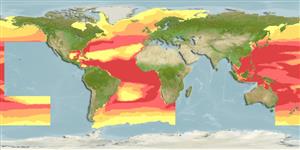Teleostei (teleosts) >
Trachichthyiformes (Roughies) >
Diretmidae (Spinyfins)
Etymology: Diretmoides: Greek, di = two + Greek, eretmos = oar + Greek, suffix, oides = similar to (Ref. 45335).
Environment: milieu / climate zone / depth range / distribution range
Ecology
Marine; bathypelagic; depth range 0 - 950 m (Ref. 9927). Deep-water
Eastern Atlantic: Guinea Bissau to Angola (Ref. 6536). Western Atlantic: eastern Florida, Gulf of Mexico, the Caribbean and northern Brazil. Indian Ocean: Mozambique, Madagascar, and Western Australia. Pacific: Indonesia, South China Sea, and Kyushu-Palau Ridge (Moore, pers. comm.).
Size / Weight / Age
Maturity: Lm ? range ? - ? cm
Max length : 37.0 cm SL male/unsexed; (Ref. 6744)
Mesopelagic. Young near the surface while aged adults often descend below 1,000 m depth (Ref. 2683). Largest adults may be benthopelagic (Ref. 9851). Plankton-eaters like the other members of the family (Ref. 6744). Breed all year round (Ref. 6744). Minimum depth range taken from Ref. 27000.
Life cycle and mating behavior
Maturities | Reproduction | Spawnings | Egg(s) | Fecundities | Larvae
Post, A., 1990. Diretmidae. p. 623-624. In J.C. Quero, J.C. Hureau, C. Karrer, A. Post and L. Saldanha (eds.) Check-list of the fishes of the eastern tropical Atlantic (CLOFETA). JNICT, Lisbon; SEI, Paris; and UNESCO, Paris. Vol. 2. (Ref. 6536)
IUCN Red List Status (Ref. 130435)
Threat to humans
Harmless
Human uses
Fisheries: of potential interest
Tools
Special reports
Download XML
Internet sources
Estimates based on models
Preferred temperature (Ref.
123201): 11.4 - 26.3, mean 18.3 °C (based on 1065 cells).
Phylogenetic diversity index (Ref.
82804): PD
50 = 0.8125 [Uniqueness, from 0.5 = low to 2.0 = high].
Bayesian length-weight: a=0.02042 (0.00806 - 0.05173), b=3.02 (2.80 - 3.24), in cm total length, based on LWR estimates for this (Sub)family-body shape (Ref.
93245).
Trophic level (Ref.
69278): 3.5 ±0.5 se; based on size and trophs of closest relatives
Fishing Vulnerability (Ref.
59153): Moderate vulnerability (35 of 100).
